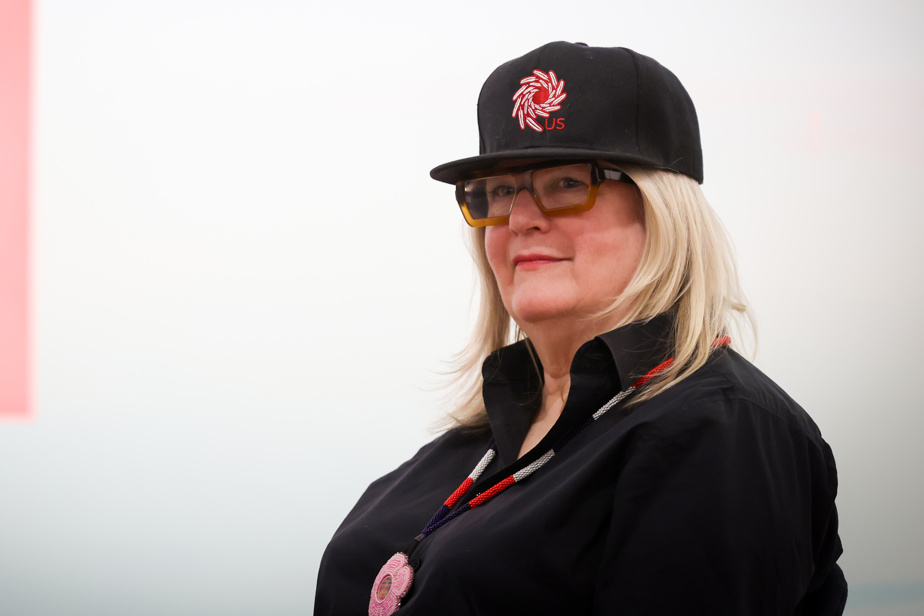Two days after the solar eclipse, the general director of the Montreal Museum of Fine Arts (MMFA), Stéphane Aquin, swears to us that the exhibition Who owns the moonby Canadian artist Wanda Koop, who painted the moon in all its forms, is the result of chance.
The artist, born in Vancouver – but who lives in Winnipeg – is presenting around twenty of her works at the MMFA, all created over the last two years, since the start of the war in Ukraine. In fact, the pieces representing the International Space Station or the Chinese Space Station are part of a series called Objects of Interest.
“In the context of the war in Ukraine, I found it amusing to include these works which represent objects which float in space and which are both extremely futile and technologically the most advanced,” says -She. I also try to create a dialectic between everything that is dark and what is luminous, alive. »
-

PHOTO FRANÇOIS ROY, THE PRESS
Ukrainian quartet, powerhouse2023
-

PHOTO FRANÇOIS ROY, THE PRESS
Series Objects of Interest brings together paintings representing the International Space Station, the Chinese Space Station, but also different representations of the moon.
-

PHOTO FRANÇOIS ROY, THE PRESS
Note for eclipse2022
-

PHOTO FRANÇOIS ROY, THE PRESS
Black Sea Portal, luminous silver, 2023
-

PHOTO FRANÇOIS ROY, THE PRESS
In the series Somnambulismwe can see four tables: Braided, Cross stitch, trickle of blood And Flowers, 2023.
1/5
You should know that the Canadian artist is herself of Ukrainian origin, her parents having left the Zaporizhia region in the wake of the Russian revolution. In a painting presented as part of the exhibition, an orange moon illuminates a power station in this region, bombed by the Russian army 100 years to the day after the departure of his parents!
The piece de resistance of Wanda Koop’s exhibition consists of four giant paintings – each 10 feet by 14 feet – representing the same landscape of the Black Sea in Crimea, but on changing color backgrounds, marking the passage of the sun at different times.
Each canvas is crossed by a vertical band which evokes a target line or a portal.
“At the start of the war in Ukraine, I found it ironic that it all started in Crimea, in 2014. It’s a region I know well, I had family there, and when Russia annexed it by force, I saw the contrast between the beauty of this immaculate sea and this other thing, horrible, that we saw, with this pretension of wanting to possess everything…”
As for the target line, Wanda Koop was inspired by it several years ago, remembering the two Gulf Wars, in 1990 and 2003, during which the whole world witnessed live – for the first time – to a war that was happening on the other side of the world. Again these wars which push humans to conquer, to possess. But to own the sea? The moon ?

PHOTO FRANÇOIS ROY, THE PRESS
One of the four giant paintings representing Crimea: Portal to the Black Sea: twilight orange2023
I remember thinking, “We are so vulnerable.” And I wanted to add this portal as a target, which could destroy the landscape at any time. But I’m not a landscaper. I put that line there to stop you from being sentimental.
Wanda Koop, visual artist
The exhibition’s curator, Mary-Dailey Desmarais, says she was “blown away” when she saw Wanda Koop’s works in her Winnipeg studio.
“Wanda’s work is much bigger than the political sphere,” she explains. His paintings condense deep reflections on the human condition and on issues linked to territory, memory, the environment and the omnipresence of war. But despite everything, we also find a lot of hope. »
Wanda Koop nevertheless considers these immense paintings to be intimate works. “I create environments that the visitor can enter. I don’t want him to feel overwhelmed. Like when we observe phenomena linked to the moon. There is a close bond that is created. Perhaps more than with a small work…”
His interest in the moon, the stars and cosmological phenomena dates back to childhood.
“I’ve been drawing the moon since I was little,” Wanda Koop tells us. I have a country house outside of Winnipeg where I live three months of the year and paint a lot. There, we can clearly see the moon, which is like a mirror. It’s as if we became aware of our smallness. I try to communicate this grandeur in my works,” the artist, who saw Monday’s solar eclipse in the Sherbrooke region, tells us.
Despite wars, cataclysms, the climate crisis and the rise of populism and the far right all over the world, Wanda Koop does not lose hope. “The arts are proof of our humanity, it’s what will save us,” she believes. I have hope in the artistic gesture, the gesture of creation. I trust that this humanity can be communicated, transmitted and spread. »
Who owns the moon (Who Owns The Moon) at the Montreal Museum of Fine Arts, from April 11 to August 4, 2024
Visit the exhibition page
